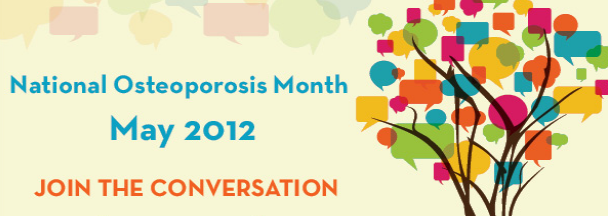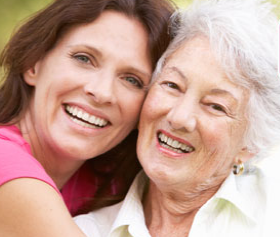Of the estimated 10 million Americans with osteoporosis – which means “porous bones” – 80% of them are women. That’s why we wanted to shine a spotlight on this condition during National Women’s Health Week. Approximately one in two women over the age of 50 will break a bone because of osteoporosis. Even more alarming is the fact that 24% of hip fracture patients age 50 and older die in the year following their fracture.
Now that you know the facts, it’s time to talk to your family about what you can do to prevent this scenario. The National Osteoporosis Foundation’s Generations of Strength Campaign encourages women (and men!) to start conversations about bone health and family history during National Osteoporosis Month. Have either of your parents experienced a broken hip, spine or wrist, for example? What about height loss or a spine that curves forward (two possible signs of broken bones in the spine)? Research shows that genetics plays a major role in osteoporosis. If either of your parents has a history of osteoporosis or broken bones, you are more likely to break a bone.
Fortunately, there are preventive steps you can take. Thirty years ago, osteoporosis was generally considered a part of normal aging. But today researchers know a lot more about how to protect your bones throughout your life. For example, getting enough calcium, vitamin D (which aids calcium absorption) and exercise is very important. Eating fruits and vegetables is also beneficial to bones. On the other hand, eating poorly, smoking, drinking too much alcohol and not exercising can cause bone loss.
In addition, researchers now have a way to detect osteoporosis before a broken bone occurs. It’s called a bone density test, and it measures your bone density in the hip and spine. That’s because fractures in these areas can cause more serious problems, including longer recovery time, greater pain and even disability. Using a Central Dual Energy X-ray Absorptiometry (DXA) machine, the test usually takes 15 minutes or less. It is non-invasive and painless. While it does expose you to radiation, you are exposed to 10-15 times more radiation flying roundtrip between New York and San Francisco.
If you’re a postmenopausal woman – or a menopausal woman with a family history of osteoporosis or other risk factors – talk to your doctor about whether you should have a bone density test. Men over the age of 50 should do so as well. Based on your resulting T-score (the measurement of bone density), your doctor can determine how healthy your bones are and whether you are a candidate for osteoporosis treatments, which can help to improve bone density and even reverse the condition to some degree. According to the 911 patients with osteoporosis at PatientsLikeMe, some of the most commonly used treatments include Fosamax, Actonel and Boniva. (Click each treatment name to see how patients evaluate the effectiveness, side effects, cost and more.)
As we wrote at the beginning of the week, women often put their needs secondary to that of their family. This is an example of how it’s crucial to prioritize your own health. Because if you break your hip, how well will you be able to care for your family then?




This article is very informative as it stresses on a healthy lifestyle and balanced nutrition as being the recommended way to preventing osteoporosis. Nowadays however a large number of nutritionists believe that a balanced nutrition should correspond to an alkaline diet in which you eat more vegetables and fruits, and less cereals, sugar and meat. Together with a de-stressed way of life and regular physical exercise, alkaline diet helps our body to avoid acidosis or body over-acidity, the leading cause of most chronic diseases, including osteoporosis. Our body cells cannot live in an acidic environment. So in case of acidosis our body strives to neutralize the acid excess by using its alkaline mineral reserves, which include the calcium from our bones. This process is a body natural defense mechanism that results unfortunately in osteoporosis.